Pantanal
 From Nwe
From Nwe 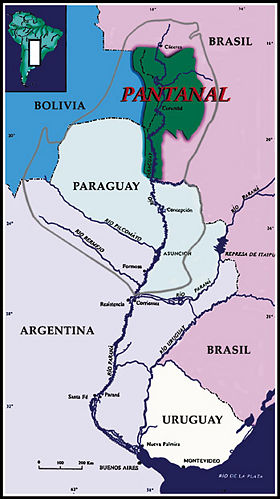
The Pantanal is considered by many to be the world’s largest, freshwater, wetland system. An immense alluvial plain, the Pantanal is situated along the northernmost part of the Paraguay River and its tributaries and becomes extensively flooded during the rainy season. It extends through millions of hectares of central-western Brazil, eastern Bolivia, and northeastern Paraguay in central South America.
The Pantanal is one of the most pristine and biologically rich environments on the planet. It also provides many economic benefits, including offering a huge area for water purification and groundwater discharge and recharge, climate stabilization, water supply, flood abatement, and an extensive, transport system, among numerous other important functions. However, despite its beauty and remarkable environmental and economic values, the Pantanal faces an uncertain future stemming from a myriad of socioeconomic pressures.
Estimates of its size range from 140,000 square kilometers (54,000 square miles) to 210,000 square kilometers (81,000 square miles), making it larger than many countries.
Location
The Pantanal is contained within the Upper Paraguay River Basin. Approximately one-third of the basin is the vast low-altitude floodplain known as the Pantanal, and two-thirds is the Planalto, or highlands.
The Upper Paraguay River Basin is the upper sub-basin of the Paraguay Basin, which is part of the 2.8 million square-kilometer Paraná Basin (or Paraná-Paraguay Basin). The Paraná basin in turn is a sub-basin of the Rio de la Plata basin (a region which also includes the Uruguay sub-basin, draining the Uruguay River, and the Salado sub-basin.)
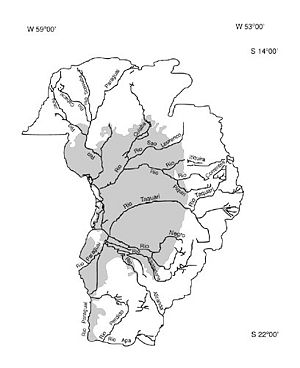
The Pantanal and Upper Paraguay River Basin extend into three nations. An estimated 80 percent of the Pantanal is located in central-western Brazil, in the two states of Mato Grosso and Mato Grosso do Sul. Another roughly 10-15 percent of the Pantanal extends into eastern Bolivia, and the remaining, smallest portion is located in eastern Paraguay. (In Bolivia and Paraguay, the Pantanal is generally referred to as "el Gran Pantanal" or "el Pantanal," while Brazilian sources often reference it as "Pantanal Matogrossense").
The Paraguay River (in Portuguese, Rio Paraguai; in Spanish, Río Paraguay), the feature that gives the Paraguay Basin its name, begins in the northern part of the watershed and extends some 2,550 kilometers southward to near Corrientes, Argentina, where it combines with the Paraná River. The headwaters of the Paraguay are located in a slightly pronounced rise, the Chapada dos Parécis, that divides the Paraguay sub-basin from the headwaters of some Amazon tributaries. Farther east, the elevated Chapada dos Guimarães forms another physical barrier between the Amazon and Paraguay River Basins.
Major tributaries of the Paraguay River within the Pantanal include the Taquari River, Miranda River, Negro River, and the Cuiabá River, as well as the São Lourenço River, which flows into the Cuiabá River, and the Aquidauana River, which flows into the Miranda River. These are all left-bank (east) tributaries arising in Brazil. Bolivian and Paraguayan tributaries are notably smaller.
Size
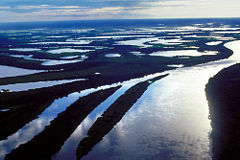
Estimates of the size of the Pantanal vary widely.
Silva and Moura (1998), who delimited and quantified only the Brazilian Pantanal, place the size of the Pantanal in Brazil at 138,183 square kilometers, and the area of the Upper Paraguay River Basin in Brazil at 361,666 square kilometers. The Brazilian Pantanal is thus 38.2 percent of its associated basin in their study. Silva and Moura define the Brazilian Pantanal as all of the continuous area inside the Upper Paraguay River Basin subjected to periodic flooding, and localized between Fazenda Barra do Ixu in the north (above Cáceres) and the confluence of the Apa River with the Paraguay River to the south (below Porto Murtinho).
A Brazilian government investigation, which utilized mainly physiomorphological mapping and considered interactions between various physical and ecological elements, established the Brazilian Pantanal at a similar surface area of 139,111 square kilometers (Brazil Ministério do Interior 1979).
However, an earlier, governmental investigation placed the dimensions of the Brazilian Pantanal at 168,000 square kilometers, the entire Pantanal of Brazil, Bolivia and Paraguay at 242,000 square kilometers, and the entire basin of the three countries at 496,000 square kilometers (Brasil Ministério do Interior 1974).
One analysis that considered only factors related to soils established the Brazilian Pantanal at an intermediate area of 153,000 square kilometers (Amaral Filho 1986).
By any measure, this is an immense region. If one considered the entire Pantanal to be but 170,000 square kilometers (17 million hectares or 42 million acres), it would still encompass an area more extensive than many countries, including England, Austria, Hungary, Greece, Ireland, or South Korea. It is larger than 29 of the states in the United States, surpassing New York, Wisconsin, and Florida. As a wetland system, it is likely the world's largest. Using figures supplied by the World Conservation Monitoring Center, the Pantanal would comprise about 3 percent of the entire world's wetlands.
Character of the Pantanal region
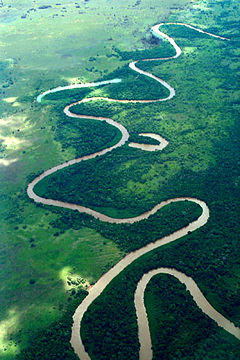
The word “Pantanal” derives from the word pantano (pantano in Spanish, pântano in Portuguese), which generally translates as swamp, marsh, or bog. However, the Pantanal is more than one of these specialized wetland types. The term designates a river floodplain region and it encompasses a variety of ecological sub-regions. Within the Pantanal are large rivers, lakes and other standing water, terrestrial ecosystems, and diverse types of riverine, lacustrine, and palustrine "wetlands"—the transitional world between aquatic and terrestrial systems. Gottgens et al. (1998) described the Pantanal is an “immense floodplain mosaic” that includes “seasonally inundated grasslands, river corridors, gallery forests, lakes and dry forests.”
In essence, the Pantanal is an immense lowlands or alluvial depression that is located along the Paraguay River and its tributaries, and that becomes extensively flooded during the rainy season. Whereas outside the Pantanal, there is a slope of about one-half to one meter drop in elevation for every kilometer traversed, within the Pantanal this gradient drops to only about 1-2 cm/km in the north-south direction and 6-12 cm/km in the east-west direction. This is a very slight slope, and when the extensive rains come during the wet season, the basin swells.
The Pantanal has two seasons: a wet season from roughly October to March, and a dry season from April to September. While the precipitation in the Upper Paraguay River Basin (annually about 800 to 1,600 millimeters, or 32-64 inches) is not substantially higher than in many other sections of Brazil, it is concentrated in this wet season, with about 80 percent of the rain falling at this time. In the more northern latitudes, the rainfall is particularly concentrated between the months of January and March, during which up to 50 percent of the annual rainfall occurs (Brasil Ministério do Meio Ambiente 1997). The combination of concentrated rainfall, very reduced topographic slope, small exit area (the Paraguay River is the only natural drainage route), and poorly drained soils results in a flooded plain. About 70-80 percent of the Pantanal region floods each wet season, with water levels as much as five meters higher than during the dry season (Junk and Silva 1995).
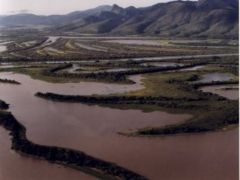
During the wet season, when the Pantanal floods, there tends to be an explosive growth of aquatic vegetation, microorganisms, and invertebrates. At this time, fish generally move laterally over the floodplain, and this is their main feeding and growing time (Lowe-McConnell 1987). The start of the flood season also corresponds to the time when most riverine fish breed, allowing the young fish to have abundant food and cover.
During the dry season, as the water retreats, there is more dry area for animals to graze, as well as pools of stranded fish that provides a feast for wading birds. Fish losses from the strandings are considered to be enormous (Lowe-McConnell 1987).
The Pantanal is a complex of diverse ecosystems, with inundated grasslands, perennial lakes, terrestrial forests, and so forth. Sanchez (1977) delineated 17 distinct sub-regions, Magalhães (1992) reported ten, and Silva et al. (1998) settled on 11 sub-regions.
The wide variety of ecological sub-regions, seasonal cycles, and successional changes, combined with abundant water and high primary productivity, contribute to the Pantanal being one of the most biologically diverse systems on the planet.
Human population
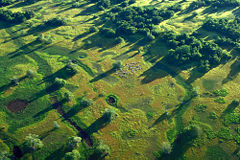
The Pantanal is sparsely populated. The Bolivian and Paraguayan areas have very low population densities; they are virtually uninhabited. Although the Brazilian side has a higher population density, it remains very low and has but 30,000 to 300,000 inhabitants, depending on how the Pantanal is delineated and which population centers are included.
In terms of the entire Upper Paraguay River Basin, there are slightly more than one million basin inhabitants in the state of Mato Grosso and about one-half million in the state of Mato Grosso do Sul (excluding the large city of Campo Grande which is on the border of the basin, but considered outside of it) (Brasil Ministério do Meio Ambiente 1997). This is a very low population density. For example, in the state of Mato Grosso do Sul, the number of people within the basin averages 2.2 inhabitants/square kilometer, compared to a national average of 17.3 inhabitants/square kilometer for Brazil itself.
The main economic activities in the Pantanal area are cattle ranching; farming of rice, soy beans, corn, and sugar cane; industries related to agriculture; mining of gold, diamonds, iron, and manganese; professional fishing; and tourism (principally sportfishing).
About two-thirds of the Brazilian Pantanal is located in the state of Mato Grosso do Sul, and one-third in the state of mato Grosso (Silva and Moura 1998). Almost three-quarters of the Brazilian Pantanal is found in four counties or districts (municípios): Corumbá, Poconé, Cáceres, and Aquidauana. The small county of Barão de Melgaço has 99.2 percent of its area designated as Pantanal, while Corumbá has 95.6 percent of its area considered to be part of the Pantanal, and Poconé 80.3 percent (Silva and Moura 1998).
Plant and animal life
 |
 |
 |
 |
The Pantanal supports a large number of species. This floodplain wetland system also has an abundantly high concentration of animals, perhaps the highest in the New World and comparable to the densest animal populations in Africa (Magnanini et al. 1985; Pádua 1991).
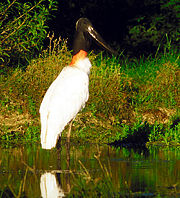
The bird population is quite diverse. In the Upper Paraguay River Basin, 656 species of birds, belonging to 66 families, have been identified (Brasil Ministério do Meio Ambiente 1997). The Pantanal itself is a major stopover point and wintering ground for migratory birds, used by birds from areas from North America, Argentina to the south, and the Andes to the West (Eckstrom 1996).
The number of fish species is also quite substantial, although far below that of the Amazon. Britski et al. (1999) catalogued 263 species of fish in the Pantanal itself, including 109 species of Characiformes, and 105 Siluriformes. This study includes all of the Pantanal proper, including the Paraguayan and Bolivian portions.
Other reports for fauna identified in the Upper Paraguay River Basin include 95 species of mammals and 162 species of reptiles (Brasil Ministério do Meio Ambiente 1997), although many of those species mainly only occur outside of the Pantanal. About half (48 species) of the identified mammal species are considered rare or in danger of extinction.
Of course, these figures are not considered to be the full story. The Pantanal has a lot of undiscovered species, and scientific expeditions to find new species generally result in the sighting of both new species and the sighting of known species not previously recorded in the Pantanal. In addition, vast sections of the Bolivian and Paraguayan Pantanal are poorly studied.
In terms of flora, Pott and Pott (1997) collected over 1,700 flowering plants during a ten-year period, and admittedly this was just a start; aquatic plants, sedges, and grasses were not even assessed.

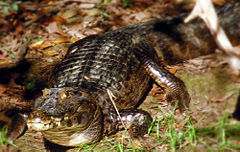
Caimans are very abundant in the Pantanal, with some estimating ten million caimans (Eckstrom 1996), giving the Pantanal the highest concentration of crocodilians in the world. In the 1970s and 1980s, an estimated one million skins a year were illegally poached.
There are an estimated half-million capybaras (Hydrochoerus hydrochaeris) in the Brazilian Pantanal. In addition, the Pantanal is one of the world's best places to see jaguars (Panthera onca), giant anteaters (Myrmecophaga tridactyla), giant armadillos (Priodontes giganteus), the endangered maned wolves (Chrysocyon brachyurus), giant river otters (Pteronura brasiliensis), and marsh deer (Blastocerus dichotomus), and all of these are considered to be largest in size in South America (Eckstrom 1996).
Fifteen species of parrots have been identified in the Pantanal, including the blue and yellow macaw (Ara ararauna), blue-fronted amazon (Amazona aestiva), green winged macaw (Ara chloroptera), red-shouldered macaw (Ara nobilis), and the endangered hyacinthine macaw (Anodorhynchus hyacinthinus), which is the largest member of the parrot family.
Other species commonly encountered in the Pantanal include the anaconda (Eunectes murinus), tapir (Tapirus terrestris), howler monkey (Allouatta caraya), Capuchin monkey (Cebus apella), coati (Nasua nasua), anhinga (Anhinga anhinga), great egret (Casmerodius albus), roseate spoonbill (Ajaia ajaja) and what is often referred to as the symbol of the Pantanal, the jaburu stork (Jabiru mycteria).
Importance of the Pantanal
The Pantanal provides innumerable economic, ecological, cultural, recreational, and aesthetic values. These include:
- One of the most substantial freshwater fisheries on the earth
- Major biogenetic reservoir
- Extensive water supply and transport system for its inhabitants
- Removes sediments and pollutants. The reduced water velocity helps in plant uptake of minerals, processing by microbes, and settlement of sediments, as well as removal of chemicals, including heavy metals, that are tied to the minerals (Gottgens 1998)
- Flood control. The Pantanal, like a giant sponge, helps to reduce and delay the flood peak, and thus reduce the flood risk. Indeed, as a result, the flood peak of the Paraguay is perhaps two to three months later than the Paraná into which it flows, thus avoiding these two flood peaks combining
- Aesthetic and peace-of-mind attributes, with the beauty and biological richness of the region
Challenges to the Pantanal's future
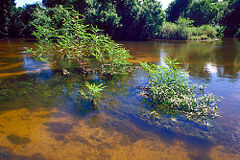
The Pantanal is relatively pristine when compared to many other wetland systems (such as the Everglades) and in particularly this is true of the interior of the Pantanal, where population and infrastructure remain low. However, if one considers the entire watershed, there are numerous challenges to the Pantanal, and likewise growing concerns within the Pantanal itself.
Water pollution is one such threat to the integrity of the Pantanal. Among the challenges are mining byproducts, agrochemicals, sewage, and garbage. Mercury contamination from its use in concentrating placer gold is one such problem. Although in 1988 Brazil prohibited using mercury in gold mining, enforcement is difficult given the isolated area and innumerable mines, and high levels of mercury have been found in fish and fish-eating birds. Fertilizers, herbicides, and pesticides used in agricultural activities, and washed into the watery environment, are another problem, particularly given that the poor soil has led to the heavy use of agrochemicals. Untreated domestic sewage and garbage are likewise discharged into the wetlands and rivers, much coming from cities and towns in the highlands outside the Pantanal. Although the Pantanal has an amazing capacity to clean the wastes and chemicals, the extent that it can absorb the increased pollution is a concern.
Loss of biodiversity. Habitat destruction, poaching, over-fishing, illegal hunting, and the business of capturing threatened and endangered species for export or for the Brazilian pet trade is causing grave concern about loss of biodiversity. Many species that were once found in large numbers, such as the giant river otter, maned wolf, ocelot, cougar, jaguar, giant anteater, marsh deer, and giant armadillo are now all listed as endangered or threatened with extinction. In all, at least 50 species are reported to be threatened or endangered in the Brazilian Pantanal. Although Brazilian environmental law is significant, enforcement is difficult, especially given that animal traffickers can easily cross over the border to Paraguay or Bolivia.

Erosion and sedimentation. The process of clearing land for agriculture, opening of new roads, logging, and extensive burning in the watershed accelerate the natural process of erosion and sedimentation. During September to October, fires are particularly prevalent, as ranchers use it to clear old pasturage and bring up tender, green shoots for cattle grazing, or as an easy means of clearing land for agriculture. Development in the Brazilian highlands, and subsequent land clearing, has lead to extensive deforestation and increased erosion. The seriousness of this threat is evident in the Taquari River, where sedimentation has lead to significant channel alteration, to the extent of the loss of over one hundred farms, branching of the river to where the channel is 30 percent of its former size, and loss of the fishing industry.

Modifications of natural cycles. The natural hydrology of the Pantanal region is also being impacted by construction of local dams and dikes, including by landowners to keep water out of their property. This creates new water-flow patterns and increased flooding outside of these areas, and decline in soil fertility as a result of loss of the periodic nutrient-replenishing flooding.
Paraguay-Paraná Waterway Project. A proposal for developing a Paraguay-Paraná Waterway or "Hidrovia" has been a recurring concern since the late 1980s, when the governments of the La Plata Basin countries (Argentina, Bolivia, Brazil, Paraguay, and Uruguay) proposed opening up over 3,442 kilometers of the Paraguay and Paraná rivers for good navigation of barge convoys. Economically, this would allow year-round cargo transport from the northernmost navigable portion of the Paraguay River to Nueva Palmira, Uruguay on the Rio de la Plata estuary, connecting to the Atlantic Ocean. Original proposals called for straightening, widening, and deepening the meandering upper stretches of the Paraguay River, including substantial dredging of the Paraguay River, removal of flow-impeding rock outcrops, channel straightening, and dike and dam construction to control the widespread flooding. While this would have potential long-term economic benefits, lowering transport costs, and assist with regional integration, this geological facelift could have considerable costs, particularly to the environment (Margolis 1995, Gottgens 1998 ). One might expect increased flooding, water contamination, erosion, disruption of natural communities, and interruption of natural cycles. The Pantanal might face substantial risk. Fauna dependent on aquatic environments would lose critical refuges, and the normal regime of flood pulses into the floodplain, so essential for sustaining diversity and productivity, would be disrupted. Farmlands would not be revitalized by the floodwaters, and serious losses of wetlands could be expected, as water flows more readily downstream. Ponce (1995) concluded that blasting rocky sills as a means of deepening the navigation channel would be the most serious intervention, irreversibly impacting the hydrology of the Upper Paraguay River and likely changing the Pantanal forever.
The original plan of channel straightening, dredging, damming, and rock removal meet opposition on economic and environmental levels and resulted in turmoil as political, economic, and environmental factions staked their claims. Ultimately, the project, as original conceived, was judged no longer viable. However, there is still concern that it will be implemented piecemeal and still impact the Pantanal in a major way (Gottgens 1998).
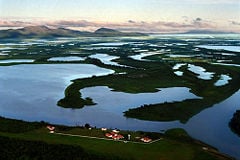
Lack of protected areas. There is little formally protected area in the Pantanal, particularly in Brazil, where most of the land is privately owned. There is a small national park, Parque Nacional do Pantanal Mato-grossense (Pantanal National Park), but this is only about 135,000 hectares, and is largely underwater. There is also the Taiamã Ecological Station, consisting of about 11,000 hectares. There is a trend to purchase private land for the sake of protecting parts of the Pantanal. However, the total protected area in Brazil, including national, state, and private protection, is only about 2 percent of the Brazilian Pantanal, with about 98 percent of the Brazilian Pantanal in private ownership.
The Bolivian Pantanal has considerably more protected area. Montaño (1999) affirms that 90 percent or more of the Bolivian Pantanal has some degree of legal protection, and substantial portions are inside of two recently created federally protected areas. The first is the Otuquis Pantanal National Park (Parque Nacional Pantanal de Otuquis) and contiguous Otuquis Natural Area of Integrated Management (ANMI Qtuquis: Área Natural de Manejo Integrado Otuquis), which occupies 1,005,950 hectares total (903,350 hectares and 102,600 hectares, respectively). The second is the San Matías Natural Area of Integrated Management—ANMI San Matías: Área Natural de Manejo Integrado San Matías—which totals 2,918,500 hectares. These two protected zones, established in 1997, were designed not only to safeguard the Pantanal but also the greater basin, including a variety of other environments, such as subhumid Chaco forests, dry forests, and so forth. It is estimated that the surface area actually occupied by the Pantanal in these areas corresponds to about 12 percent of the San Matías protected area and 24 percent of the Otuquis protected area (Montaño 1999). Furthermore, the San Matías Natural Area of Integrated Management lies proximate to Pantanal National Park of Brazil, thus permitting the establishment of an extensive tract that will aid preservation efforts.
Other issues
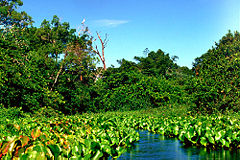
Ecotourism. Ecotourism is a potential long-term hope for the Pantanal, bringing in tourist dollars to the local communities and thus creating an economic incentive for these communities to preserve the environment. Generally, ecotourism is considered tourism to relatively intact natural areas, which has low impact on the environment, promotes conservation, and provides a beneficial socioeconomic return to the local populations. With tourism being one of the world's largest businesses, ecotourism might offer a profitable, long-range financial medium that could be more lucrative than other, more environmentally deleterious economic activities. However, several obstacles remain to ecotourism's viability. In the Pantanal, there is a serious lack of infrastructure, such as accommodations and transportation. There is a lack of tourist information and trained guides are few. Furthermore, the region remains poorly known in many nations, including the United States. Ecotourism has not yet been substantially developed in the Pantanal region, and in particular the Bolivian Pantanal is practically inaccessible and ecotourism undeveloped, due to lack of tourist facilities and a transport infrastructure (Herrera 1995). The Brazilian portion of the Pantanal is somewhat better situated and is visited by hundreds of biologists and thousands of tourists a year, but much of the Brazilian tourism is centered on fishing. Pseudo-ecotourism packages, versus true ecotourism, can have an adverse effect by disturbing the natural areas, increasing illegal activities, and heightening demand for facilities, infrastructure, and luxury items.
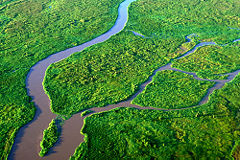
Cattle raising. One of the chief economic activities in the Pantanal is cattle ranching. This enterprise is perhaps unique in that it is a widespread economic activity that impacts the landscape, but which many authorities do not see as a big environmental problem. Instead, it is generally presented as a long-term activity that developed in harmony with the environment or which at least poses minimal negative impacts. One reason offered for such a view is that the Pantanal has many, natural grassland areas that do not require the type of deforestation one might find in the Amazon, and also because cattle are often allowed free to graze on unaltered land. Furthermore, extensive flooding during the wet season can limit the amount of cattle raised on a piece of land to the pasturage available when much of the land is submerged. For these reasons, cattle raising is often promoted as a viable economic activity for the future of the Pantanal. Nevertheless, cattle ranching is not without its problems and detractors who see it as a problem. One can observe burning of wild landscapes in order to clear land for cattle or to bring up fresh shoots. Native plant life may be selected against, and the moving of cattle to new pastures can result in widespread loss of native vegetation. There are concerns regarding the effect of cattle grazing on soil erosion and sedimentation and the loss of wildlife refuge for native populations. The impact of cattle grazing on the Pantanal remains hotly debated.
National initiatives. There are also a number of national initiatives directed at management of the Pantanal, with Bolivia active in creating national reserves, and Brazil developing an institutional mechanism via the formation of high-level committees and environmental programs, involving not only federal and state governmental bodies, but also the private sector, professionals, and NGOs.
References
ISBN links support NWE through referral fees
(Much of the original source of this article was excerpted from Swarts (2000) by permission of the author and the copyright holder, Waterland Research Institute.)
- Alho, C. J. R., and L. M. Vieira. 1997. Fish and wildlife resources in the Pantanal wetlands of Brazil and potential disturbances from the release of environmental contaminants. Environ. Toxic. Chemistry 16 (1): 71-74.
- Amaral Filho, Z. P. do. 1986. Solos do Pantanal Matogrossense [Soils of the Matogrossense Pantanal]. In: Simpósio sobre recursos naturais e sócio-economicos do Pantanal 1 (Corumbá, MS, Brazil). Anais... Brasilia, Embrapa-DDT, p. 91-104. (EMBRAPA-CPAP Documentos, 5).
- Banks, V. 1991. The Pantanal: Brazil's Forgotten Wilderness. San Francisco: Sierra Club Books.
- Barbier, E. B., M. Mike Acreman, and D. Knowler. 1997. Economic Valuation of Wetlands: A Guide for Policy Makers and Planners. Gland, Switzerland: Ramsar.
- Bonetto, A. A., and I. R. Wais. 1995. Southern South American streams and rivers. In River and Stream Ecosystems, Edited by C. E. Cushing, K. W. Cummins and G. W. Minshall, 257-292. Amsterdam: Elsevier.
- Bonetto, A. A., I. R. Wais, H. P. Castello, and L. I. de Cabo. 1990. Wetland management in the "Gran Pantanal," Paraná basin, South America. In The People's Role in Wetland Management, Proceedings of the International Conference on Wetlands, eds. M. Marchand and H. A. Udo de Haes, 218-224. Leiden, Netherlands, June 5-8, 1989.
- Brasil, Ministério do Interior. 1979. Estudo de Desenvolvimento Integrado da Bacia do Alto Paraguai: Relatório da 1o Fase, Descrição Fisica e Recursos Naturais [Study of the Integrated Development of the Upper Paraguay River Basin: Report of the First Phase, Physical Description and Natural Resources]. Brasilia: SUDECO/EDIBAP.
- Brazil, Ministério do Interior. 1974. Estudos Hidrologicos da Bacia do Alto Paraguai [Hydrological Studies of the Upper Paraguay River Basin]. Rio de Janeiro: DNOS (National Department of Works and Sanitation), Vol.1.
- Brasil Ministério do Meio Ambiente, dos Recursos Hídricos e da Amazônia Legal (MMA). 1997. PCBAP: Plano de Conservação da Bacia do Alto Paraguai (Pantanal), Vol. III, Análise Integrada e Prognóstico da Bacia do Alto Paraguai [Conservation Plan for the Upper Paraguay River Basin (PCBAP)]. Brasília: PNMA.
- Britski, H. A., Keve Z. de S. de Silimon, and Balzac S. Lopes. 1999. Peixes do Pantanal: Manual de Identificação [Fish of the Pantanal: Manual of Identification]. Brasília: Embrapa-SPI; Corumbá: Embrapa-CPAP.
- Da Silva, J. dos Santos Vila, and M. de Moura Abdon. 1998. Delimitação do Pantanal Brasileiro e suas sub-regiões. [Delineation of the Brazilian Pantanal and its sub-regions]. Pesq. Agropec. Bras., 33 (Numero Especial):1703-1711.
- Eckstrom, C. K. 1996. A wilderness of water: The Pantanal. Audubon 98(2): 54-65.
- Gottgens, J. F. et al. 1998. The case of the Paraguay-Paraná waterway ("Hidrovia") and its impact on the Pantanal of Brazil: a summary report to the Society of Wetland Scientists. Wetlands Bulletin, pp. 12-18.
- Herrera, J. O. 1995. Las maravillas del Pantanal boliviano [The marvels of the Bolivian Pantanal]. Revista Boliviana de Cultura 5 (10).
- Honey, M. S. 1999. Treading Lightly? Ecotourism's impact on the environment. Environment 41 (5): 4-9, 28-33.
- Junk, W. J., and C. J. da Silva. 1995. Neotropical floodplains: A comparison between the Pantanal of Mato Grosso and the large Amazonian river floodplains. In Limnology in Brazil. Edited by J. G. Tundisi, C. E. M. Bicudo and T. Matsumura Tundisi. Brazilian Academy of Sciences and Brazilian Limnological Society.
- Kwak, C. H. 2000. The Pantanal and the Pantaneiors: Heartfelt challenges and new opportunities. In F. A. Swarts (ed.) The Pantanal. St. Paul, MN: Paragon House.
- Lowe-McConnell, R. H. 1987. Ecological Studies in Tropical Fish Communities. Cambridge: Cambridge University Press.
- Magalhães, N. W. de. 1992. Conheça o Pantanal [Know the Pantanal]. São Paulo: Terragraph.
- Magnanini, A., et al. 1985. Pantanal. Trans. by Paulo Fernando Henriques Britto. Rio de Janeiro: AC&M.
- Margolis, M. 1995. Treasuring the Pantanal. International Wildlife 25(6):12-21.
- Mitsch, W. J., and J. G. Gosselink. 1993. Wetlands. 2nd Edition. New York: Van Nostrand Reinhold.
- Montaño Cuchallo, M. E. 1999. Unpublished communication with Frederick A. Swarts. (November 24, 1999, Email.)
- Pádua, M. T. 1991. Quoted in Vic Banks, The Pantanal: Brazil's Forgotten Wilderness. San Francisco: Sierra Club Books.
- Ponce, V. M. 1995. Hydrologic and Environmental Impact of the Paraná-Paraguay Waterway on the Pantanal of Mato Grosso, Brazil: A Reference Study. San Diego, CA: San Diego State University Report.
- Por, F. D. 1995. The Pantanal of Mato Grosso (Brazil): World's Largest Wetlands (Monographie Biologicae, V. 73). Dordrecht, Netherlands: Kluwer Academic.
- Pott, A., and V. J. Pott. 1997. Plants of the Pantanal. Brasília: Embrapa-SPI.
- Sanchez, R. O. 1977. Estudo Fluviomorfológico del Pantanal: Regionalización, Sub-regionalización y Sectorización Geográfico de la Depression de la Alta Cuenca del Rio Paraguai. EDIBAP.
- Sparks, R. E. 1995. Need for ecosystem management of large rivers and their floodplains. BioScience 45 (3): 168-182.
- Swarts, F. A. 2000. The Pantanal in the 21st Century: For the planet's largest wetland, an uncertain future. In F. A. Swarts (ed.) The Pantanal. St. Paul, MN: Paragon House. ISBN 1557787913.
- Swarts, F. A. (Editor). 2000. The Pantanal: Understanding and Preserving the World's Largest Wetland. St. Paul, MN: Paragon House. ISBN 1557787913. (Originally published as The Pantanal of Brazil, Bolivia and Paraguy by Hudson MacArthur Publishers.)
- Swarts, F. A. 2000. The Land of the Great Heartbeat. World & I 15 (2): 156-163.
- Wade, J. S. 1999. The Brazilian Pantanal and Florida Everglades: A comparison of ecosystems, uses and management. In Anais do II Simpósio Sobre Recursos Naturais e Sócio-econômicos do Pantanal: Manejo e conservação (November 18-22, 1996, Corumbá, MS, Brazil), 29-37. Corumbá: Embrapa Pantanal.
Credits
This article began as an original work prepared for New World Encyclopedia and is provided to the public according to the terms of the New World Encyclopedia:Creative Commons CC-by-sa 3.0 License (CC-by-sa), which may be used and disseminated with proper attribution. Any changes made to the original text since then create a derivative work which is also CC-by-sa licensed. To cite this article click here for a list of acceptable citing formats.
Note: Some restrictions may apply to use of individual images which are separately licensed.↧ Download as ZWI file | Last modified: 02/04/2023 00:23:14 | 49 views
☰ Source: https://www.newworldencyclopedia.org/entry/Pantanal | License: CC BY-SA 3.0
 ZWI signed:
ZWI signed: KSF
KSF